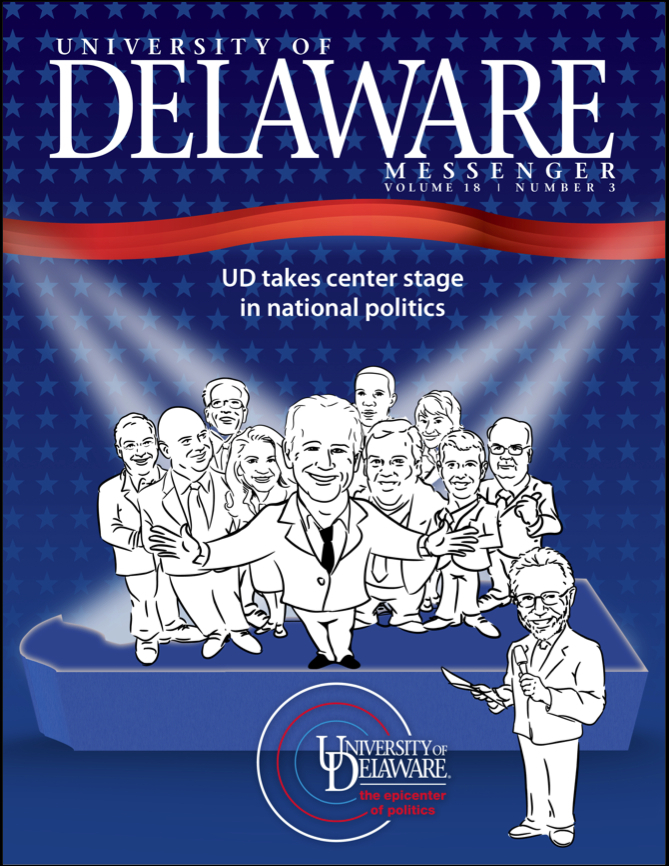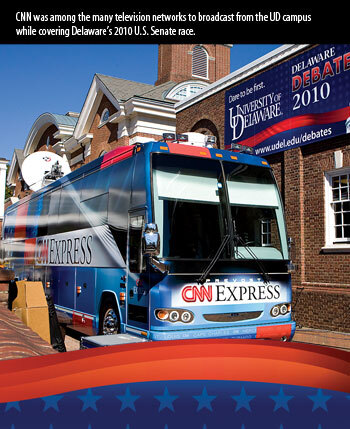Campus shines in national spotlight : UD takes center stage in national politics

The University of Delaware Messenger (Volume 18 #3, December 2010) recognized the work of the Center for Political Communication and co-host/producer Delaware First Media in the following feature about the nationally recognized Delaware Debates, which debuted in October 2010. Photos by Ambre Alexander, Kathy F. Atkinson, Evan Krape, Duane Perry and Kevin Quinlan.
With a U.S. Senate race that attracted extraordinarily widespread attention to the state of Delaware during the fall campaign season, the University was uniquely positioned to showcase and share its expertise in the world of politics.
And it made the most of the opportunity.
From candidate debates, including one that drew some 160 journalists from around the globe to Mitchell Hall and was televised on CNN, to live-from-campus morning news broadcasts on major networks, UD was often in the spotlight. In addition to the debates and media interest, the University in recent months has hosted prominent speakers on a variety of political topics, conducted polling of the state’s electorate and shared the expertise of faculty in such areas as political science, policy and political communication.
Playing a key role in all these events and activities was UD’s Center for Political Communication (CPC), a multidisciplinary and nonpartisan initiative launched in fall 2009 to focus on this emerging field of study that is growing and developing alongside the burgeoning use of digital technologies by candidates and the public. When the center was established, officials noted an article by Bloomberg News that called the University “the epicenter? of the 2008 presidential campaign because of the work by alumni, specifically Vice President Joseph R. Biden Jr., Obama campaign manager David Plouffe and McCain senior strategist Steven Schmidt. In 2010, another UD alumnus, Chris Christie, became the high-profile governor of New Jersey.
“There are obviously many other outstanding universities where students can learn about politics and policy,” Ralph Begleiter, the CPC director, said at the center’s inaugural event. “We think we”re among the first to recognize political communication, especially involving new technologies and an electorate increasingly using them, as a distinct field worthy of study by students, faculty researchers and practitioners.”
Begleiter, who is Rosenberg Professor of Communication and Distinguished Journalist in Residence at UD, brings more than 30 years of broadcast journalism experience to the center, including two decades as CNN’s world affairs correspondent.

Without a doubt, the 2010 campaign-season event that brought the most attention to the University came on Oct. 13, with a much-anticipated U.S. Senate debate between Republican Christine O”Donnell and Democrat Chris Coons. The debate was co-hosted by the CPC and Delaware First Media.
CNN’s Wolf Blitzer, co-moderator of the debate with Nancy Karibjanian of Delaware First Media, began broadcasting early in the day from a makeshift studio at South College and Amstel avenues. Later, Blitzer anchored CNN’s The Situation Room from the site. A CNN camera on The Green featured shots of the University’s signature buildings throughout the day.
As the day wore on, the campus was filled with more than 160 broadcast and print journalists, including about 50 international reporters. In addition to a packed Mitchell Hall, those on campus interested in the debate viewed the proceedings from an auditorium in Wolf Hall and in the food court at the Trabant University Center.
Outside Mitchell Hall, a public expression area was established, where about 200 supporters of the two candidates turned out with signs and banners. Inside, the candidates answered questions posed by Blitzer and Karibjanian and later responded to videotaped questions from UD students.
Following the debate, reporters had access to a ‘spin room,” where representatives of the candidates offered their take on the event. Also, David Wilson, assistant professor, and Jason Mycoff, associate professor, both in the Department of Political Science and International Relations, and Delaware Gov. Jack Markell addressed the press. The next morning, several networks”CBS, ABC, NBC, MSNBC and CNN”broadcast from campus.
A week before the debate, the event was previewed by Rachel Maddow, host of MSNBC’s The Rachel Maddow Show, who visited Newark and the campus to focus on the Senate race and to broadcast her hour-long show from the Deer Park Tavern near campus.
Just after the debate, the University conducted a telephone poll of likely Delaware voters, which found that a solid majority of viewers believed that Coons had won the debate and that few of those surveyed had changed their minds about which candidate they were supporting. This National Agenda opinion poll followed a similar one conducted before the debate, which showed Coons with a 19-point lead four weeks before Election Day.
The National Agenda Poll, which also found Democratic congressional candidate John Carney with a 17-point lead over Republican Glen Urquhart four weeks before the election, was overseen by Prof. Wilson, the CPC’s coordinator of public opinion initiatives.
The University also hosted a 90-minute debate between Carney and Urquhart in early October that was attended by more than 500 people and could be viewed through streaming video online and via C-SPAN.
In addition to candidates for public office, several prominent speakers appeared on campus in the days and weeks before Election Day to discuss political issues. Best known, and most contentious, were Karl Rove and Howard Dean, who spoke jointly as part of the UD Speaks series to an audience of about 2,000 on Oct. 25 and didn’t hesitate to disagree with each other.
Rove, who was senior adviser to President George W. Bush, is widely regarded as the architect of Bush’s two successful presidential campaigns. Dean ran for the Democratic presidential nomination in 2004 and served as Democratic National Committee chairman from 2005-2009. Despite their disagreements on virtually all the issues discussed, both Rove and Dean paid tribute to Delaware’s retiring U.S. Congressman Mike Castle, who attended the event, and praised his many accomplishments while in office.
Both men now provide commentary to national media outlets. Their appearance at UD, dubbed “Election Eve: Howard Dean and Karl Rove Together,” provided the audience with insider views of the political process.
Also speaking in separate appearances on campus this fall, as part of the CPC’s ongoing National Agenda lecture and discussion series, were Patti Solis Doyle, manager of Biden’s 2008 vice presidential campaign; Jim Crounse, one of the top direct mail consultants for the Democratic Party; and Kenneth Vogel, a reporter for Politico.com.
Teamwork showcases UD at its best

Throughout the 2010 campaign season, numerous members of the UD community”faculty, staff, students, alumni and partners”labored to ensure that the many political events on campus ran smoothly.
“I strongly believe that UD’s prominence in the political arena in recent weeks would not have occurred had we not been prepared to take advantage of the moment,” Ralph Begleiter, director of the University’s Center for Political Communication said in thanking those who contributed their time and expertise to the Delaware Debates 2010 events, which drew national and international attention. “Guests of the University – were treated to a world-class experience on our campus.”
Among the efforts that made UD’s time in the spotlight shine were those of University Media Services, whose professionals spent months to prepare for and produce the televised programming of the debates, which Begleiter, a former CNN correspondent, called “technically perfect.” Media Services staff provided high-definition technology, camera and audio production work, video animations and satellite uplinks, among many other services.
The stage set for the debates was designed by the Office of Communications and Marketing (OCM) and constructed by the Department of Theatre, whose students also served as ushers. OCM designers created the “Dare to be first? and other banners that were placed around campus for national viewing, and the office’s media relations specialists handled credentials and other necessities for visiting media.
The Development and Alumni Relations staff planned and hosted special receptions after the debates; faculty members provided expert commentary; UD Facilities workers prepared Mitchell Hall and the rest of the campus to look its best for the cameras and visitors; and Public Safety worked with other police agencies to provide security for candidates, journalists and the public.
A Firsthand Experience of the Delaware Senatorial Debates

Students assisted with recording and editing the taped questions posed to the candidates by other students, in addition to numerous other tasks. Here is an account from Delaware First Media interns Ian Clark and Andrew Frischman:
As seniors at UD, we have seldom seen our student body so passionate about anything. As we walked down The Green, it was astonishing to see Mitchell Hall, an auditorium that went generally unnoticed every day as we walked by, transformed into the epicenter of a nationally televised debate. Many supporters had assembled outside. People chanting, the CNN production truck, big news station camera crews and even a few people wearing witch outfits brought the campus to life in a way we had never seen before.
The night of the debate, we showed up for production assistant duties, and saw our own co-workers and managers from DFM working alongside CNN staff members setting up camera angles, checking audio equipment and adjusting the set. When we walked into the control room, we saw producers from both companies finalizing preparations for the night’s productions, and we saw one of our own professors and Delaware First Media vice president, Nancy Karibjanian, preparing to co-moderate with Wolf Blitzer. When the event was over, we walked out onto The Green to the bustle of news crews looking to get the reactions of those inside. For once, it was nice to see UD on the receiving end of the camera lens.
